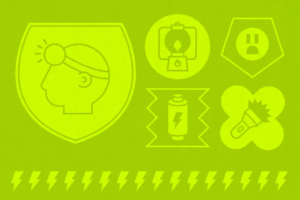Last Updated on August 27, 2024 by Mary Pressler
US homeowners deal with 5.5 hours of power outages per year on average, according to the Energy Information Administration (EIA). However, power interruptions can extend for several days during extreme weather events, especially if the local grid has been damaged. For example, millions of Texans were left without electricity for days after Winter Storm Uri in 2021 and Hurricane Beryl in 2024. Here we review the most important items you should include on your power outage kit list while discussing some backup power options for your home.
The Power Outage Emergency Kit Checklist
The American Red Cross provides a detailed list of emergency supplies for power outage situations. They also provide general recommendations on how to prepare for power outage instances, including how to stay safe and protect your electrical devices and property.
Here, we summarize your power outage emergency kit checklist and offer a few additional preparation tips.
1) Food That Doesn’t Require Refrigeration or Cooking
You should avoid opening your refrigerator during a blackout to keep its interior cold and preserve your food for as long as possible. Cooking also becomes an issue since even gas stoves depend on electronic controls. Even if you have an older stove that does not require electricity, you should not cook indoors during a blackout – your kitchen hood has no power, and harmful combustion gases can accumulate.
Considering these issues, your power outage kit should include food supplies that don’t require refrigeration or cooking. Here are some good options:
- Canned foods (make sure you have a can opener)
- Snack bars
- Nuts and dried fruit
- Peanut butter
You can also keep a stock of dehydrated meals, which can be ordered online and have a shelf life of up to 10 years.
2) Sufficient Water for Everyone in Your Home
Having drinking water at hand is critical during an extended power outage. Even if your tap water is of drinkable quality, it will not be available if pumping systems are without power. The American Red Cross recommends keeping one gallon of water per household member per day. Based on this rule, if your household has four members and you want to prepare for a 5-day power outage, you must keep 20 gallons of water in stock.
3) Medication, Especially if It Requires Prescription
Going to the local pharmacy is more difficult when traffic lights and street lamps are off, and also consider that businesses without a backup generator will be closed. Getting prescription medicine is even more difficult during a power outage since you also need to visit your doctor. For this reason, you should keep a first aid kit and any prescription medicine required by your household members.
4) Personal Hygiene Items
During extended power outages, personal hygiene products tend to run out in supermarkets and convenience stores. You should keep a stock of personal hygiene items specifically for your power outage kit. Disinfecting wipes and hand sanitizer are especially helpful since they can help you save water during an extended blackout.
5) Additional Supplies for Hot and Cold Weather
Remember that a power outage leaves you without air conditioning and space heating. This also applies if you have a gas-fired heater since its controls and fans run on electricity. You will want to be prepared for power outages that happen when the weather is very hot or cold.
- For summer blackouts, consider portable fans with rechargeable solar batteries.
- For winter blackouts, consider sleeping bags and additional blankets.
6) Electronic Gadgets and Other Convenience Items
Your power outage kit list should also include flashlights and enough batteries. LED flashlights are strongly recommended since their low power consumption maximizes battery life. You should also keep an emergency radio with a hand crank or solar battery to catch up on local news. Your kit should also include a power bank in case you need to recharge smartphones and other electronic devices.
If someone in your household uses refrigerated medication, a portable cooler with rechargeable batteries is strongly recommended. If the power outage extends for several hours and your refrigerator warms up, you can use the portable cooler to preserve mediation.
Cash is another important element of your power outage emergency kit checklist since debit and credit card payments may be unavailable at local businesses.
7) Consider a Backup Power System
If you want to be extra prepared for a blackout, consider purchasing a portable generator or rechargeable solar battery.
- Portable generators are typically designed to run on gasoline or diesel, and you can find 10-kilowatt generators for less than $1,000.
- Solar batteries come in many sizes. If you only want to power a few small devices, you can find solar battery kits for less than $2,000. However, a larger battery capable of powering your entire home can cost upwards of $10,000.
- Solar battery systems are more expensive than traditional generators, but they have the advantage of not requiring fuel, which can run out during emergencies.


Leave a Reply
Want to join the discussion?Feel free to contribute!